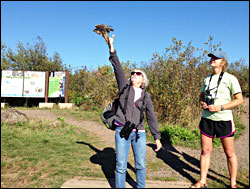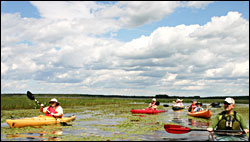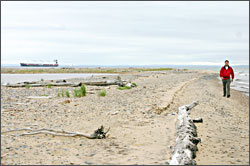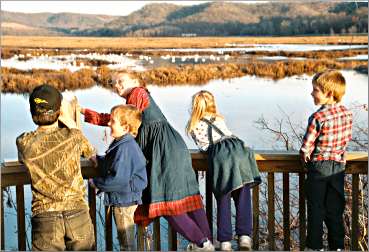5 great places to watch birds in fall
Tag along with experts, and you'll get to see the migration up close.

© Beth Gauper
In fall, the birders come out to watch the annual migration of hawks, waterfowl and swans.
The rest of us come out to watch the birders, because they see things the rest of us don't.
At the annual Hawk Weekend on Duluth's Hawk Ridge, renowned author and ornithologist Laura Erickson had eagle eyes trained on the sky, as usual.
"There's a sharp-shinned hawk with a songbird in its crop," she noted to anyone who cared to listen. "Since it's just eaten, it probably won't fly any closer, but it might if it sees easy pickings."
But we didn't need to see one closer, because soon two young naturalists walked over from the banding station, holding newly banded sharpies.
One had yellow eyes and dark-brown breast feathers, and the other had orange eyes and reddish coloring. After explaining the differences — one was a juvenile, the other an adult — they invited two onlookers to hold and release the birds.
Thanks to them, you don't need to own binoculars or even know anything about birds to appreciate the fall migration. Here are five places where you can bird-watch with the pros.
Hawk Ridge in Duluth, Minn. Funneled between land and the vast waters of Lake Superior, waves of raptors pass above this ridge every fall: sharp-shinned and broad-winged hawks in September and red-tailed and rough-legged hawks in October, along with goshawks and a few early eagles.
At the banding station, staff members catch hungry birds with decoys and band them in hopes of finding out more about their migrations.
Naturalists are at the nearby interpretation area every day, letting visitors release the newly banded birds and answering questions.
Programs and workshops are held on weekends, and bird hikes at 8 a.m. Wednesdays and Saturdays. Evening owl programs also are scheduled.

© Beth Gauper
For more, see Hawk heaven.
Crex Meadows in Grantsburg, Wis. Just 100 miles south of Duluth, near the St. Croix River, the 30,000-acre Crex Meadows Wildlife Area is a sandy plain that is home to osprey, sandhill cranes, trumpeter swans and all kinds of migrating fowl.
A self-guided, 24-mile driving tour takes visitors through wetlands, lakes, prairie and sedge marsh, where the Crex Carpet Co. harvested grass for rugs from 1912 to 1933.
The Crex friends' group organizes talks, tours and events year-round at the Wildlife Education and Visitor Center.
In October, the public is invited to meet for Sunset With the Sandhills Tours, to see cranes fly in from daytime feeding grounds to their roosting areas. Register in advance.
The annual Crane Festival includes field trips, tours and talks.
Horicon Marsh between Horicon, Waupun and Mayville, Wis. This is the largest freshwater cattail marsh in the United States; it's often called the Everglades of the North.
The southern third of the 33,000-acre marsh is a state wildlife area and is home of the Horicon Marsh Education and Visitor Center and the hands-on Explorium. The northern two-thirds is a national wildlife refuge and includes a Visitor Center on the east side.
Both areas have hiking trails and observation decks. A 50-mile auto route girds the marsh, and the 34-mile Wild Goose State Trail skirts its western edge.
The refuge offers events every weekend from April through November, plus guided hikes and a crane watch. National Wildlife Refuge Week is celebrated the second full week of October.

© Beth Gauper
For more, see Life on Horicon Marsh.
Whitefish Point Bird Observatory near Paradise, Mich. At the southeast corner of Lake Superior near the Soo Locks, thousands of migrating birds are funneled past this point, adjacent to Seney National Wildlife Refuge and next to the Great Lakes Shipwreck Museum.
Fall migration includes raptors, including eagles, and many varieties of ducks and shorebirds.
Whitefish Point also hosts large numbers of migrating owls, many of which staff members catch and band in spring and fall.
Like Duluth's Park Point, its shoreline is home to small populations of the endangered piping plover.
For more, see Graveyard of the Great Lakes.

© Beth Gauper
Upper Mississippi River National Wildlife and Fish Refuge from Winona, Minn. When ponds in southern Canada and North Dakota start to ice over in late October, tundra swans fly down to feast on arrowhead tubers and wild celery in the sloughs of the Mississippi River before continuing east.
In Alma, Wis., the Wings Over Alma Nature & Art Center on Main Street has an outdoor viewing deck with spotting scopes. It also organizes a Tundra Swan Watch in November, with naturalists providing information and spotting scopes.
From Winona, the fish and wildlife service offers a Tundra Swan Watch bus tour in mid-November. Passengers will visit Weaver Bottoms marshes just south of Weaver, Minn., then travel to the Brownsville Overlook viewing decks.
On-board interpreters answer questions and provide binoculars and spotting scopes.
Refuge staff and volunteers staff the Brownsville Overlook viewing decks from 10 a.m. to 2 p.m. every Saturday and Sunday in November. They're three miles south of Brownsville off Minnesota 26.
For more, see Wings over the Mississippi.